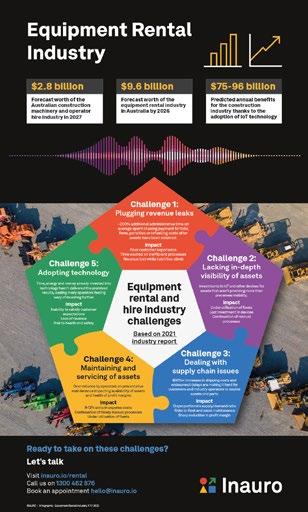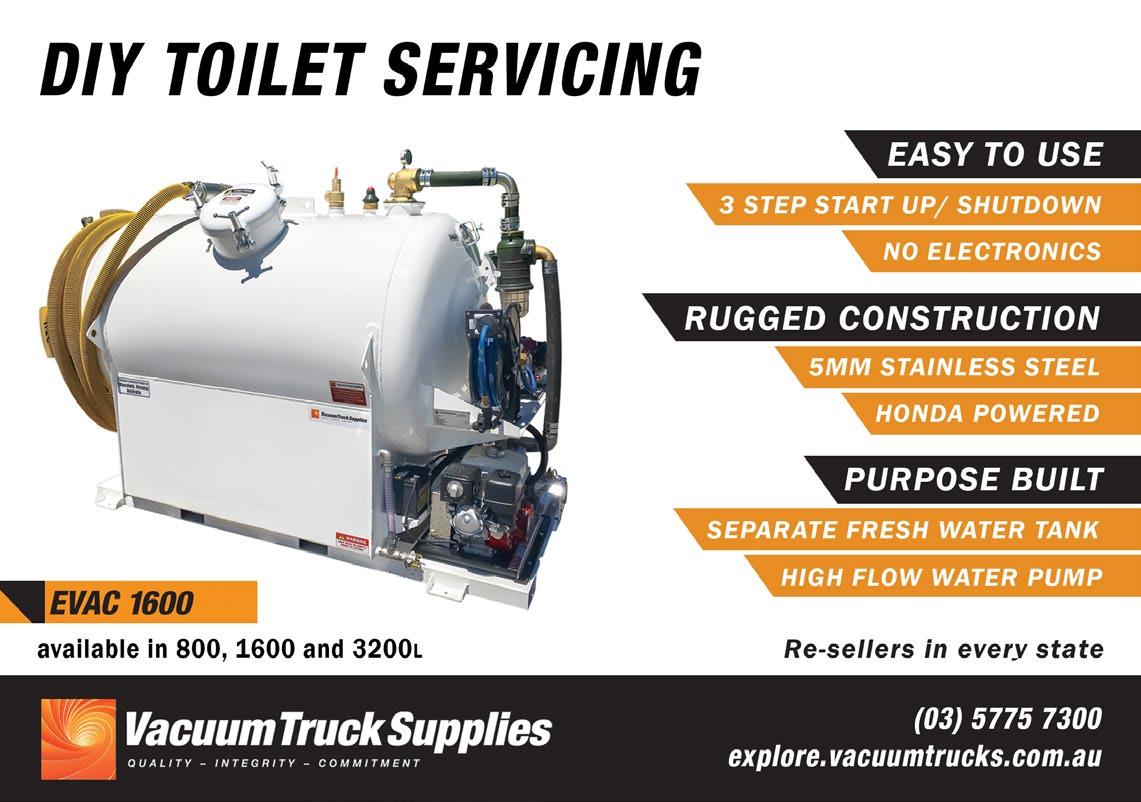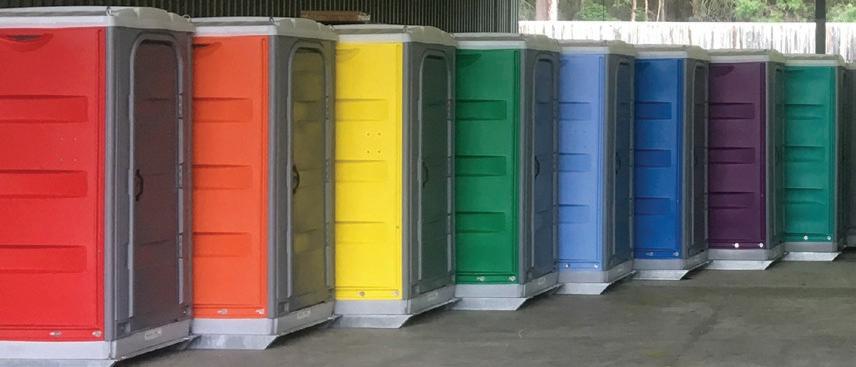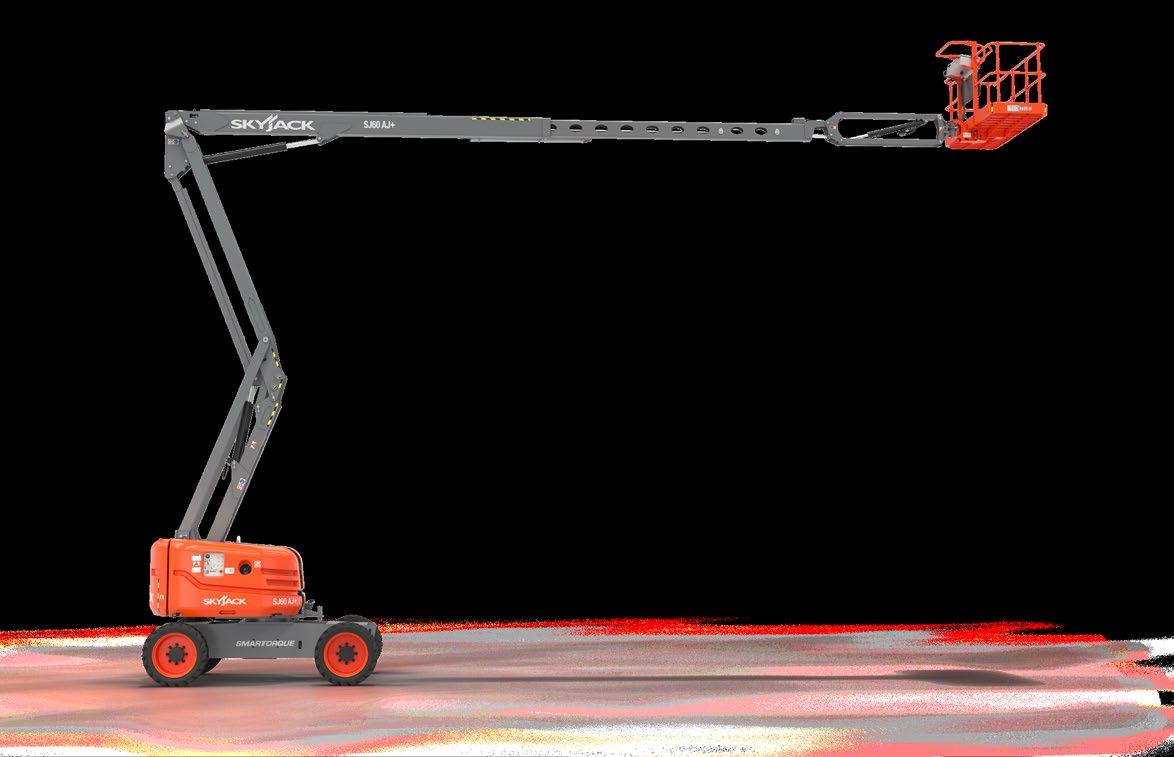
5 minute read
Automation’s role in plugging revenue leaks
The role of automated workflows in plugging revenue leaks
Four years of economic growth is predicted for the hire industry but it’s the commitment to data that determines your share of the rewards, says Max Girault, Chief Commercial Officer at Inauro.
The vision of workflow automation company Inauro, is “to put people first and make their lives easier”. In their February 2022 industry report, “The Future of the Equipment Rental Industry: establishing a foundation for success”, the tech company co-founded by Angus Kennard and Craig Kesby identified five challenges facing hire operators today, and the function of automation in reducing the risks of being left behind.
The IBISWorld 2021 forecast of the Australian hire industry’s value is $9.6 billion by 2026. This is largely due to government stimulus and infrastructure funding. A choked supply chain favouring equipment hire over purchase for the foreseeable future plays a significant part in the calculation, too.
Inauro’s report names five challenges for hire companies to consider for maximising profits from the good times ahead. We spoke with Max Girault about their challenge number one — a longstanding obstacle for hire operators — plugging revenue leaks.
“Revenue leaks is a common problem in rental and one that’s not easily seen, as it’s not reported on,” said Max. “Issues such has over-utilisation of equipment, toll recovery and stand downs were difficult to get a grip on before telematics made this data available, and these can add up. It is pure margin. But telematics doesn’t go far enough to solve this, and that’s where we come in.”
Max is referring to Inauro’s PerspioTM platform. It’s the software that connects telemetry with the business context, enabling automation to plug those gaps.
Planning with data
Many hire companies install telematics to capture asset data, but it’s what you do with the reports that leads to savings, according to Max.
“Generally, taking the next step is in the category of ‘wouldn’t it be great if …’, and then the idea is quickly filed in the too hard cabinet,” he said. “’We know we are losing a bit of money but that’s how it’s always been right?’ is where they leave it. The technology is there today so it really comes down to business benefit.”
In Max’s experience, moving to automated workflows is mostly driven by improving client satisfaction, and cost control. “Hire companies always need to develop their customer offerings to ensure they give the best possible experience and make it easier for their customers to rent rather than buy, but we know margins are getting thinner,” he said. “Automation solves both those issues. It generally doesn’t come down to a single use case, although the ROI is generally achieved as quickly as implementation of the first use case. Collectively there is a lot of value to generate from leveraging data in the right way.” Inauro’s hire industry clients have been surprised by some unexpected discoveries revealed by workflow automation. “When you rent out a piece of equipment, no matter what it is you are expecting, you think the customer knows what to use it for and that the instructions you give them will be respected,” said Max. “They are not. Telemetry gives you that visibility to identify wrong uses. There are also lots of challenges with data in a rental operation, because a lot of it is still manual, and the amount of admin time saved and given back to the business is significant.”
Inauro often sees evidence of data challenges that are a result of clients putting information together from different sources that should be the same. Problems occur when data is wrongly entered in one system, or managed differently, making it hard to work with.
“Some are wildly different and that typically shows something is going wrong,” said Max. “Simply being able to show you how many assets are out from the yard and not on a contract generally gets people interested,” said Max. “But it’s not just about tracking devices, as these are now commoditised. The greater value comes from the integration of systems and the automation this enables.”


Taking the leap
Feedback to Inauro from the hire industry shows there is still a perception that ‘automation is hard’, and ‘too different from traditional bricks-and-mortar ways of working’. But, like all things tech adopted by business, in the past decades, the incentives to change in efficiency, cost-savings, client demands and emission control will combine to drive change.
“Customers are demanding access to the data of the equipment, and if you don’t have a way to provide them access to their asset’s data only, and only for the rental contract period, then they’ll find someone else who can,” said Max. “A lot of this has been driven in the US where companies like United Rentals and Sunbelt are way ahead of the pack. Europe is not far behind, and we are seeing more and more interest in Australia, especially with the bigger hire companies.”
There is still wariness about committing to automation, adds Max.
“Tracking has been a cost on the balance sheet for a while, and it’s now time to turn this around,” he said. “We know that some major contracts have been lost because of a lack of a telematics offering, which is becoming increasingly important. And it’s not necessarily only the big operations that benefit from the technology. We are working with smaller operations like Hire Express, who came to us to help with improving customer experience and better manage revenue leaks. We’ve worked with other customers who have gone from a three percent toll recovery to 97 percent from one day to the next.”
Inauro’s five challenges for equipment rental in 2022
1. Plugging revenue leaks 2. Lacking in-depth visibility of assets 3. Dealing with supply chain issues 4. Maintaining and servicing assets 5. Adopting technology
Download and read the full report at
https://www.inauro.io/rental

R O I
E-POWERED PTIMISED DESIGN NCREASED CAPACITY
. . . . Increased capacities New Kubota engines SMARTORQUE™ extended to the SJ60 AJ+ model 20% lower gross vehicle weight (GVW) on
SJ45 AJ+ and SJ60 AJ+ models
With these changes, rental companies can quickly improve their return on investment.










